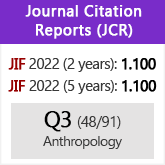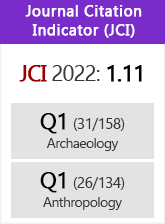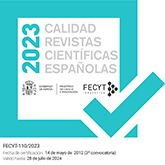In half light. Later Prehistoric carvings in Galician rock shelters
DOI:
https://doi.org/10.3989/tp.2012.12081Keywords:
Landscape Archeology, Recent Prehistory, Schematic Art, Ritual Space, Weapons, HuntingAbstract
The systematic survey of rock art in the area of the town council of Porto do Son (A Coruña) has allowed us to find nearly two hundred carved surfaces, two of them located within rock shelters. Two other examples in the Western regions of Galicia must be added to those. The motifs inside the rock shelters are exactly the same as those found in the open-air petroglyphs, which can be roughly dated to the third millennium BC. These finds attest to the existence of an intentional constraint on the visibility of these graphic manifestations. The coexistence of motifs inside cavities and others located outdoors, even on fairly conspicuous vertical friezes, shows the variability of this phenomenon and allows us to reflect on the different audiences at which the rock sites would have been aimed.
Downloads
References
Aparicio Casado, B. 1995: “Etnoarqueología de los grabados rupestres de la provincia de Pontevedra”. Actas del XXII Congreso Nacional de Arqueología (Vigo 1993) 2: 111-116. Vigo.
Aparicio Casado, B. 1996: “La interpretación popular de los grabados rupestres gallegos”. En A. A. Rodríguez Casal (ed.): Humanitas: estudios en homenaxe ó Prof. Dr. Carlos Alonso del Real. Universidade de Santiago de Compostela. Santiago de Compostela: 257-284.
Bahn, P. 2001: “Save the Last Trance for Me: An Assessment of the Misuse of Shamanism in Rock Art Studies”. En H. P. Francfort, R. N. Hamayon y P. G. Bahn (eds.): The Concept of Shamanism: Uses and Abuses. Akadémiai Kiadó. Budapest: 51-94.
Bradley, R. 1997: Rock art and the prehistory of Atlantic Europe: singing the land. Routledge. Londres.
Bradley, R. 1998: The significance of monuments. On the shaping of human experience in Neolithic and Bronze Age Europe. Routledge. Londres.
Bradley, R. 2000: An archaeology of natural places. Routledge. Londres.
Bradley, R. 2002: “Access, style and imagery: the audience for prehistoric rock art in Atlantic Spain and Portugal, 4000-2000 BC”. Oxford Journal of Archaeology 21 (3): 231-247. http://dx.doi.org/10.1111/1468-0092.00160
Bradley, R. 2009: Image and Audience. Rethinking Prehistoric Art. Oxford University Press. Oxford.
Bradley, R.; Criado Boado, F. y Fábregas Valcarce, R. 1994: “Rock art research as landscape archaeology: a pilot study in Galicia, north-west Spain”. World Archaeology 25: 374-390. http://dx.doi.org/10.1080/00438243.1994.9980252
Bradley, R. y Fábregas, R. 1999: “La ley de la frontera: grupos rupestres galaico y esquemático y prehistoria del Noroeste de la Península”. Trabajos de Prehistoria 56 (1): 103-114. http://dx.doi.org/10.3989/tp.1999.v56.i1.292
Casimir, M. J. 1992: “The determinants of rights to pasture: territorial organization and ecological constraints”. En M. J. Casimir y A. Rao (eds.): Mobility and territoriality: social and spatial boundaries among foragers, fishers, pastoralists, and peripatetics. Berg. Nueva York: 153-203.
Cernadas Sande, J. 2007: Gravados rupestres nos montes de Carnota. TresCTres. Santa Comba.
Criado Boado, F. y Vaquero Lastres, J. 1993: “Monumentos, nudos en el pañuelo, Megalitos, nudos en el espacio: Análisis del emplazamiento de los monumentos tumulares gallegos”. Espacio, tiempo y forma. Serie I, Prehistoria y arqueología 6: 205-248.
Darvill, T. 2002: “White on blonde: quartz pebbles and the use of quartz at Neolithic monuments in the Isle of Man and Beyond”. En A. Jones y G. MacGregor (eds.): Colouring The Past. The significance of colour in archaeological research. Berg. Nueva York: 73-92.
Díaz-Andreu García, M. 1998: “Iberian post-palaeolithic art and gender: discussing human representations in Levantine art”. Journal of Iberian Archaeology 0: 33-52.
Eguileta Franco, J. M.; Fernández Ibáñez, C. y Seara Carballo, A. 1993-1994: “Un campaniforme cordado procedente de A Limia (Ourense)”. Brigantium 8: 57-68.
Fábregas Valcarce, R. 2010: Os petróglifos e o seu contexto. Un exemplo da Galicia meridional. Instituto de Estudios Vigueses. Vigo.
Fábregas Valcarce, R.; Rodríguez Rellán, C. y Rodríguez Álvarez, E. 2010: “New approaches to the configuration and the spatial distribution of prehistoric rock art in the North of the Barbanza Peninsula (Galicia, NW of Spain)”. En A. Bettencourt, M. J. Sanches., L. B. Alves y R. Fábregas Valcarce (eds.): Conceptualising Space and Place: On the role of agency, memory and identity in the construction of space from the Upper Palaeolithic to the Iron Age in Europe. British Archaeological Reports International Series 2058, Archaeopress. Oxford: 133-140.
Forteza González, M.; García Sanjuán, L.; Hernández Arnedo, M. J.; Salguero Palma, J.; Wheatley, D. W. 2008: “El cuarzo como material votivo y arquitectónico en el complejo funerario megalítico de Palacio III (Almadén de la Plata, Sevilla): análisis contextual y mineralógico”. Trabajos de Prehistoria 65 (2): 137-150.
Gómez Fernández, A. y Vázquez Domínguez, M. 2009: “La ocupación romana del yacimiento de Castelo de Chás: A Cova dos Mouros (Oimbra, Ourense)”. Gallaecia 28: 139-150.
Guerra Doce, E. y López Sáez, J. A. 2006: “El registro arqueobotánico de plantas psicoactivas en la prehistoria de la Península Ibérica. Una aproximación etnobotánica y fitoquímica a la interpretación de la evidencia”. Complutum 17: 7-24.
Ingold, T. 1987: The appropriation of nature: essays on human ecology and social relations. University of Iowa Press, Iowa City.
Insoll, T. 2004: Archaeology, Ritual, Religion. Routledge. Londres.
Kehoe, A. 2000: Shamans and Religion: An anthropological Exploration in Critical Thinking. Waveland Press. Londres.
Lewis-Williams, D. 2002: The Mind in the Cave: consciousness and the origins of art. Thames and Hudson. Londres.
Mañana Borrazás, P. y Santos Estévez, M. 2002: “Arte rupestre no Promontorio de Corme (Ponteceso)”. Gallaecia 21: 115-126.
Martinón Torres, M. 2006: “On the life-histories of megaliths in Northwest Iberia”. En A. A. Rodríguez Casal (ed.): Mégalithisme atlantique. The Atlantic megaliths. Acts of the XIVth UISPP Congress (Liege, Belgium, 2001), British Archaeological Reports, International Series 1521, Archaeopress. Oxford: 43 51.
Peña Santos, A. de la y Rey García, M. 2001: Petroglifos de Galicia. Vía Láctea. A Coruña.
Ramil Rego, E. y Ramil Soneira, J. 1995: “A Pena Grande (Santaballa, Villalba), un yacimiento de finales del Paleolítico al norte de la provincia de Lugo”. En Actas del XXII Congreso Nacional de Arqueología (Vigo, 1993) 1: 351-356. Vigo.
Rodríguez Rellán, C. y Fábregas Valcarce, R. 2011: “La industria lítica en el Noroeste de la Península Ibérica durante el III y el II Milenios a.C.” En M. P. Prieto-Martínez y L. Salanova (eds.): Las comunidades campaniformes en Galicia. Cambios sociales en el III y II Milenios BC en el NW de la Península Ibérica. Diputación Provincial de Pontevedra. Pontevedra: 249-258.
Rodríguez Rellán, C.; Fábregas Valcarce, R.; Eiroa Pose, A.; Rodríguez Álvarez, E. y Gorgoso López, L. 2010: “Alén da fronteira naturalista na arte rupestre galega: estacións con zoomorfos na Costa da Morte (A Coruña)”. Gallaecia 29: 83-102.
Rodríguez Saiz, E.; Hidalgo Cuñarro, J. M. y Suárez Otero, J. 1996-1997: “Nuevos datos sobre prehistoria viguesa: estudio de los materiales arqueológicos de las cavidades de ‘O Folón’ (Coruxo)”. Castrelos: Revista do Museo Municipal ‘Quiñones de León’ 9-10: 55-80.
Santos Estévez, M. 1999: “A arte rupestre e a construcción dos territorios na Idade do Bronce en Galicia”. Gallaecia 18: 103-118.
Santos Estévez, M. 2005a: “La caza ritual en la Edad del Bronce y su representación en el arte rupestre de Galicia”. En M. Santos Estévez y A. Troncoso Meléndez (eds.): Reflexiones sobre el Arte Rupestre, paisaje, forma y contenido. Traballos de Arqueoloxía e Patrimonio 33, Instituto de Estudios Galegos Padre Sarmiento, CSIC - Xunta de Galicia. Santiago: 83-100.
Santos Estévez, M. 2005b: “Sobre la cronología del arte rupestre atlántico en Galicia”. Arqueo web (Revista Electrónica) 7(2), sept./dic. 2005. http://www.ucm.es/info/arqueoweb/pdf/7-2/santos.pdf (consulta 21-IX-2011).
Scarre, C. 2002: “Epilogue: Colour and Materiality in Prehistoric Society”. En A. Jones y G. MacGregor (eds.): Colouring The Past. The significance of colour in archaeological research. Berg. Nueva York: 227-242.
Suárez Otero, J. 1997: “Del yacimiento de A Cunchosa al Neolítico en Galicia. Primera aproximación al contexto cultural de la aparición del Megalitismo en Galicia”. En A. A. Rodríguez Casal (ed.): O neolítico atlántico e as orixes do megalitismo: actas do Coloquio Internacional. (Santiago de Compostela, 1996): 485-506. Santiago de Compostela.
Taçon, P. 1994: “Socializing landscapes: the long term implications of signs, symbols and marks on the land”. Archaeology in Oceania 29: 117-129.
Tilley, C. 1994: A Phenomenology of Landscape: Places, Paths and Monuments. Berg. Oxford.
Tilley, C. 2004: The Materiality of Stone: Explorations in landscape phenomenology 1. Berg. Oxford.
Tilley, C. 2008: Body and Image: Explorations in landscape phenomenology 2. Left Coast Press. California.
Vázquez Rozas, R. 1995: “Los petroglifos gallegos: selección de su emplazamiento y selección de las rocas grabadas”. En Actas del XXII Congreso Nacional de Arqueología (Vigo, 1993) 1: 69-76. Vigo.
Vázquez Rozas, R. 1997: Petroglifos de las Rías Baixas gallegas: análisis artístico de un arte prehistórico. Diputación Provincial de Pontevedra. Pontevedra.
Vázquez Rozas, R. 1998: “El significado de los petroglifos”. En F. J. Costas y J. M. Hidalgo (eds.): Reflexiones sobre el arte rupestre prehistórico de Galicia. Asociación Arqueológica Viguesa. Vigo: 43-68.
Vázquez Varela, J. M. 2000: “Significados y funciones de los grabados rupestres prehistóricos de armas metálicas en el Noroeste de la Península Ibérica”. Cuadernos de Estudios Gallegos 47/113: 9-25.
Vilaseco Vázquez, X. I. y Fábregas Valcarce, R. 2008: “Dos finais do II Milenio A.C. á Segunda Idade do Ferro: o asentamento fortificado de Os Pericos (Ribeira, A Coruña)”. Gallaecia 27: 89-112.
Downloads
Published
How to Cite
Issue
Section
License
Copyright (c) 2012 Consejo Superior de Investigaciones Científicas (CSIC)

This work is licensed under a Creative Commons Attribution 4.0 International License.
© CSIC. Manuscripts published in both the printed and online versions of this Journal are the property of Consejo Superior de Investigaciones Científicas, and quoting this source is a requirement for any partial or full reproduction.All contents of this electronic edition, except where otherwise noted, are distributed under a “Creative Commons Attribution 4.0 International” (CC BY 4.0) License. You may read here the basic information and the legal text of the license. The indication of the CC BY 4.0 License must be expressly stated in this way when necessary.
Self-archiving in repositories, personal webpages or similar, of any version other than the published by the Editor, is not allowed.

















